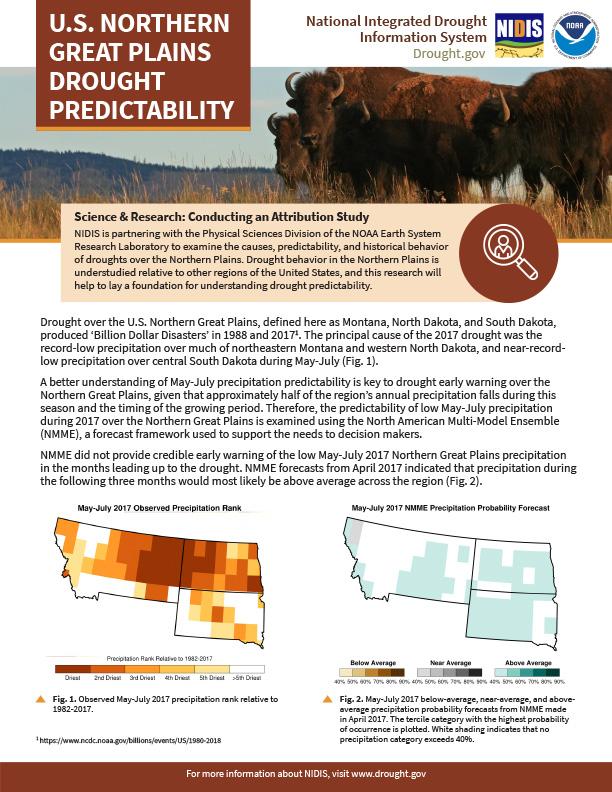U.S. Northern Great Plains Drought Predictability
Drought over the U.S. Northern Great Plains, defined here as Montana, North Dakota, and South Dakota, produced ‘Billion Dollar Disasters’ in 1988 and 2017. The principal cause of the 2017 drought was the record-low precipitation over much of northeastern Montana and western North Dakota, and near-record-low precipitation over central South Dakota during May-July.
A better understanding of May-July precipitation predictability is key to drought early warning over the Northern Great Plains, given that approximately half of the region’s annual precipitation falls during this season and the timing of the growing period. Therefore, the predictability of low May-July precipitation during 2017 over the Northern Great Plains is examined using the North American Multi-Model Ensemble (NMME), a forecast framework used to support the needs to decision makers.
NMME did not provide credible early warning of the low May-July 2017 Northern Great Plains precipitation in the months leading up to the drought. NMME forecasts from April 2017 indicated that precipitation during the following three months would most likely be above average across the region.
The Heidke skill score, which quantifies how often a forecast category matches the observed category, illustrates strong year-to-year variations in NMME precipitation prediction skill over the Northern Great Plains. These year-to-year variations in skill appear to be independent of the observed precipitation magnitude. NMME precipitation prediction skill over the Northern Great Plains for 2017 was among the lowest during 1982-2017. However, the low precipitation during the ‘Billion Dollar Disaster’ in 1988 was skillfully forecast.
Methods
Observed precipitation is based on the 1˚x1˚ analysis of the Global Precipitation Climatology Centre and forecast precipitation is based on the North American Multi-Model Ensemble (NMME). Utilized is an ensemble of 104 predictions from eight forecast systems initialized in April for every May-July season during 1982-2017. Precipitation during a given May-July, for both observations and the 104 predictions, is assigned to either below-average (lower 33.3%), near-average (middle 33.3%) or above-average (33.3%) categories. The forecast probability of below-average, near-average and above-average precipitation during each May-July is taken as the percentage of the 104 NMME forecasts that fall into the three categories, respectively.
The Heidke skill score4 is used to measure the performance of NMME forecasts. The Heidke skill score compares how often a forecast category matches the observed category beyond what is expected by chance. The forecast category with the highest probability of occurrence among the 104 NMME forecasts for a given May-July is the forecast category for the purposes of skill assessment. Skill scores less than 0 indicate no prediction skill while scores approaching 100 indicate increasing skill compared to a random forecast.
Science & Research: Conducting an Attribution Study
NIDIS is partnering with the Physical Sciences Division of the NOAA Earth System Research Laboratory to examine the causes, predictability, and historical behavior of droughts over the Northern Plains. Drought behavior in the Northern Plains is understudied relative to other regions of the United States, and this research will help to lay a foundation for understanding drought predictability.


